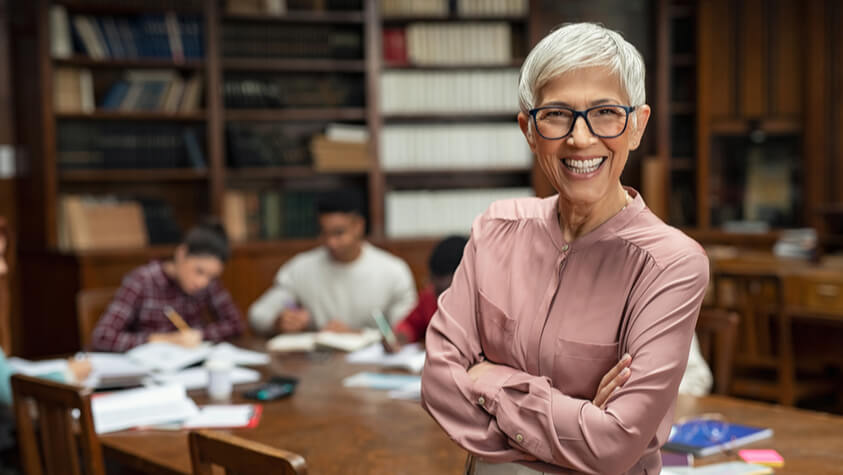By TACP Staff on August 15th, 2019

While categorized as educators, art professors surpass traditional boundaries of academics. Igniting the passion of their pupils is the true calling of the professor of art; and to do that, one must have experienced it both personally and educationally. This career begins with a strong determination to transform artistic determination into a qualified and licensed teaching credential, MA or Ph.D.
The ability to express yourself through art, or knowing how to understand the influence of art on our culture and history is a valuable part of the human experience. For individuals to become art professors they need to have a true appreciation and commitment to both art, and the students they plan to influence. In most cases, art professors must master their artistic craft, and invest in between six and ten years of higher education, including earning both a bachelor’s and master’s degrees or beyond.
Art professors must be a teacher and an artist simultaneously, and those who can achieve this can be quite satisfied with the impact they have on their students and the world.
Art professors are artists themselves and often have a specialized interest in a certain area of the arts, such as painting, drawing, sculpture, or graphic design. They also must have a strong understanding of art history. In most cases, art professors begin their academic journey as an undergraduate art major and earn either a Bachelor of Arts (BA) or Bachelor of Fine Arts (BFA). Those who wish to teach at the college level will go on to pursue a Master’s degree or Doctoral degree in Art.
Art professors must also obtain teacher certification in the state where they plan to teach. While it is not absolutely necessary that their undergraduate degree is in art, such a degree usually gives a candidate a better chance of acceptance into an art graduate program that will be required in order to become a professor. Having a strong portfolio of their own work can also help them advance between an undergraduate degree and a graduate degree.
Those who pursue a career as an art professor face a high level of competition, and it is common for new professors to start their careers as adjunct professors rather than full professors who are working toward tenure. Adjunct professors are usually hired one semester at a time and are not paid as much as full professors. Instead, they are often brought in by universities to teach entry-level courses that students take to meet general requirements. The pay is also less for an adjunct professor than for a full professor, but the experience is invaluable and is widely accepted as part of the process.
To become an art professor, a person should have a high level of interest and skill in the art, in a generalized sense as well as in the area they plan to give special focus. They should have the desire to share their passion for art, and the patience to encourage those at different skill levels to find a medium of art that they too will use to express themselves.
Because the world of art uses both pen and pencil or brush, as well as computer hardware and software, an art professor must be fluent in both. Some common software that proves invaluable in the classroom is Apple’s iLife and iWork, as well as Inspiration. Photoshop Elements, Picasa, iPhoto and Print Shop are also great tools to bring out the artist in any student.
Art Professors should also have the ability to present the best and most interesting aspects of various mediums of art and be able to organize the material so that it can be presented in a way that allows students to be both active and passive learners. They should also be able to relate the style of art they are teaching, both to the period of time when it first became popular as well as modern times, and be able to defend their own views on the material they teach while respecting those who have different styles or opinions than their own.
First and foremost, an art professor should be willing to continue to be a student themselves and have the ability to conduct research, write effectively, and communicate well with students, other professors, and the artistic community. They must be able to offer a fair and objective eye when reviewing the work of students and find a way to present feedback that will help them reach their goals.
Because there are new and ongoing developments that occur in the field of art, art professors, like other professors, must continue to be active artists, and present themselves as experts in their field beyond the scope of their own classrooms and teaching studios. In doing so, an art professor will be required to be more than a teacher. They must find the time and space to continue to produce work and expand their own art portfolio. A strong portfolio will help maintain their status as a working artist and also help with their credibility, both with prospective students and with the higher education institutions where they may wish to teach or publish.
In addition to producing quality artistic pieces, art professors can also take advantage of research facilities on the campuses where they work to write academic papers both on their own and in collaboration with other artists or educators, on and off-campus. By maintaining a wide range of industry connections, professors are better able to serve their students, especially those who ultimately plan to pursue work as an artist as well.
Often, academic knowledge helps maintain the credibility of individual pieces within a portfolio and may help a professor make the leap from adjunct professor to a more permanent position on a tenure track that draws in talented students with high potential of making notable contributions of their own.

The Art Career Project is a trusted resource for emerging and professional artists.